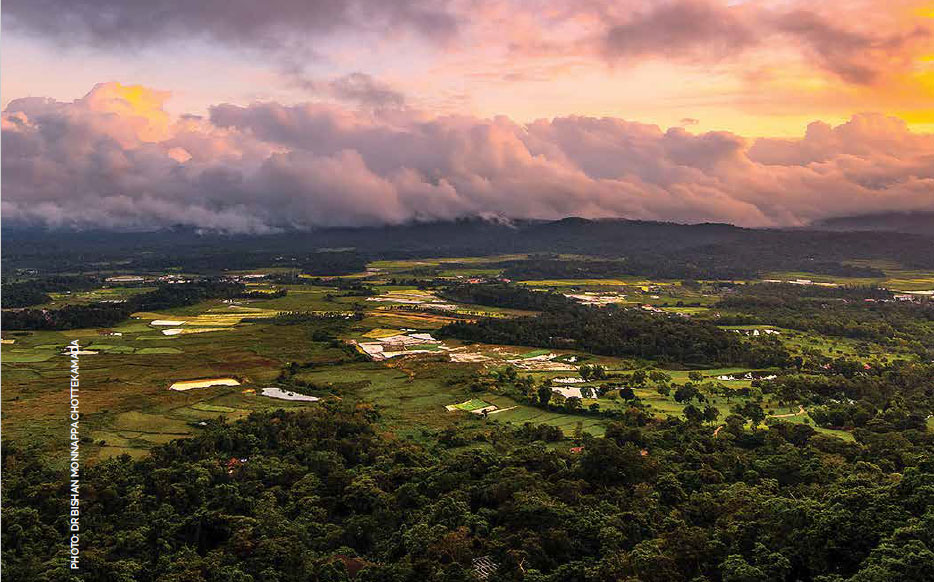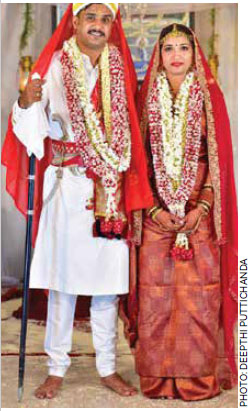India’s immense cultural diversity is arguably the world’s richest intangible heritage. Very little of this diversity has been documented and preserved for future generations. The lesser-known communities, their history, their origins, their unique social and cultural markers needs to be documented for posterity before they vanish from our cultural map.
![]() One such unique and small community, barely two lakhs in number, is a martial race that resides in the Western Ghats. They are the Kodavas and their land is Kodagu, a district in Karnataka. Earlier they were called Coorgs and the land was called Coorg. The name change came after the reorganization of States when Coorg at that time a C State was merged with the State of Karnataka.
One such unique and small community, barely two lakhs in number, is a martial race that resides in the Western Ghats. They are the Kodavas and their land is Kodagu, a district in Karnataka. Earlier they were called Coorgs and the land was called Coorg. The name change came after the reorganization of States when Coorg at that time a C State was merged with the State of Karnataka.
The Kodavas worship nature and ancestors. It is the land of coffee and spices. It has the highest per capita number of serving and retired Generals, Air Marshals and Admirals in the country! The Kodavas identify themselves with clans and are famous for the inter family hockey and golf tournaments with hundreds of participating families.
The India Foundation for the Arts [IFA] is a not-for-profit organization which implements projects across practice, research and education in the arts and culture in India. IFA was commissioned to create Sandooka-The Living Museum of Kodava Culture, an interactive online space to showcase the rich and thriving culture of the Kodavas of Kodagu, Karnataka. This virtual platform is a repository of the multi-dimensional cultural narratives of the land and its people and the manner in which these have evolved over the ages.
Sandooka (Chandooka in the Kodava language) means a treasure chest, a familiar term in many parts of the country. It is a treasure chest found in many homes, symbolizing the collection and preservation of material objects and cherished memories.
Sandooka has been in the making for near two years. It has brought to life, through meticulous field research along with diverse materials contributed by the community, the integral experience of Kodava heritage, landscape, traditions and culture. The idea to create a virtual museum came up at the time of the pandemic.
The pandemic and its impact on the ways of thinking and human behaviour changed the world in ways we could not have imagined. The travel and hospitality sectors were crippled beyond belief.
Words like hybrid and virtual have come into the lexicon of tourism. This is the new reality. Monuments, cultural heritage sites and famous museums across the world have gone hybrid to provide ‘online’ guided tours through their sites and galleries to millions who are unable to travel for one reason or another. The cultural reach has grown exponentially. In India, the Government has announced plans to provide online access to major museums and UNESCO World heritage sites in the country. Technology makes this possible and opens the doors to the magical world of virtual museums.


![]()
![]()
The project team brought together different expertise to put this museum together. Designers, graphic artists, photographers, animators, content writers and online technology experts joined hands to undertake this complex task. They travelled extensively in Kodagu to record festivals, traditional homes, marriages and unique ceremonial practices and the landscape itself. The support from eminent scholars, writers, artists and many others from the community helped us to put together an authentic narrative of the customs and culture of the land and its people.
![]() The Virtual Museum of Kodava Heritage was completed earlier this month and was formally launched online. The narrative in the Museum is spread across nine categories. These address Architecture, Arts and Crafts, Community Histories, Clothes and Jewellery, Cuisine, Customs and Rituals, Festivals, Landscape and Literature and Folklore. The website also has a glossary of commonly used Kodava terms and a list of book and website resources.
The Virtual Museum of Kodava Heritage was completed earlier this month and was formally launched online. The narrative in the Museum is spread across nine categories. These address Architecture, Arts and Crafts, Community Histories, Clothes and Jewellery, Cuisine, Customs and Rituals, Festivals, Landscape and Literature and Folklore. The website also has a glossary of commonly used Kodava terms and a list of book and website resources.
As a corollary to the Sandooka Museum, a digital repository of artefacts from different parts of Kodagu, representing Kodava culture is also being created and will be uploaded as a companion platform. This is just the begining of the story. Sandooka will be a living museum, a continuing work in progress as it were. There will be a constant exercise to update, bring in new information and arrange interaction on subjects of relevance and community interest. It is conceived as a dynamic repository of cultural stories and related information.
There was a time when the geographically challenged confused Coorg with Coonoor! That was in line with the times when in the thinking of most people from South India, north was Punjab and for those in the north, South India was just Madras and nothing else! Tourists have become discriminating and throwing the travel net wider discovered Coorg.
![]() With its numerous luxury resorts, pristine natural beauty, thousands of square miles of coffee plantations, large number of home stays, three golf courses and a golf resort, wildlife sanctuaries, Coorg has become a very popular tourist destination.
With its numerous luxury resorts, pristine natural beauty, thousands of square miles of coffee plantations, large number of home stays, three golf courses and a golf resort, wildlife sanctuaries, Coorg has become a very popular tourist destination.
The Virtual Museum of Kodava Culture could not have come at a better time. It will add a dimension to the tourist experience that is unparalleled. For the diaspora and those travellers who look beyond the obvious, it will provide an extremely enriching cerebral experience.
ABOUT THE AUTHOR
![]() Rathi Vinay Jha is retired IAS officer, served as secretary tourism, textiles and was founder director, NIFT. She also served as CMD of ITPO.
Rathi Vinay Jha is retired IAS officer, served as secretary tourism, textiles and was founder director, NIFT. She also served as CMD of ITPO.